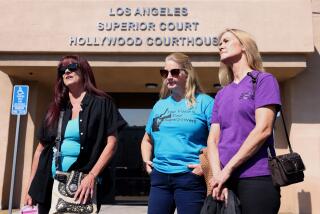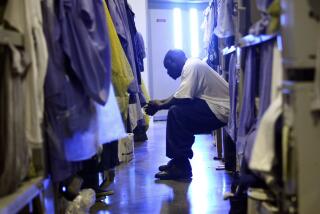Parolee Boom Raises the Ire of Concerned Communities
SACRAMENTO — While state prison officials at a widely publicized hearing last month delayed the release of Arthur Jackson, who has served more than six years in prison for attempting to murder actress Theresa Saldana, another 240 or so inmates quietly joined the fast-growing ranks of parolees living in Los Angeles County.
For every well-known prospective parolee such as Jackson, hundreds of anonymous inmates serve their sentences and are paroled from prison with $200 in their pockets and an uneasy hope that they can jump-start their lives on the outside.
Without fanfare, they report to parole offices tucked into office buildings and suburban shopping centers throughout the county. Under the wary eyes of parole agents, they seek jobs and homes in neighborhoods from Glendale to Gardena and from the Antelope Valley to Azusa.
Growing Population
The state Department of Corrections estimates that during the next five years, the parolee population in Los Angeles County will climb by about 65%, from 22,000 to almost 37,000, costing taxpayers about $45 million more a year.
“These people live next door to you. . . . They can live anywhere,” said Edward Freeman, an assistant parole unit supervisor in North Hollywood. “When you put these guys in, they’ve got to come out sooner or later.”
State Sen. Robert Presley (D-Riverside), chairman of a joint legislative committee on prison construction, acknowledged that the public probably is unaware “that there are just hundreds and hundreds” of parolees who, like Jackson, “committed serious offenses.”
The explosion in the prison population--just last week it was disclosed that corrections officials estimate that they need to build about 15 more prisons in addition to those already planned--is expected to fuel a tremendous new surge in the number of parolees.
Even before the recent projections, the county’s escalating parolee population had helped kindle community opposition to new parole offices in the San Gabriel Valley and Long Beach. Meantime, it also has highlighted a long-simmering debate about the role of agents, who are assigned to help inmates re-enter society while protecting public safety.
The Department of Corrections, with an overall budget of about $2 billion this fiscal year, has earmarked approximately $200 million for about 1,100 parole agents--whose ranks have more than doubled in the past three years.
The budget to supervise parolees is expected to continue to climb because corrections officials predict that the number of parolees in California will soar from the present level of 54,000 to 82,250 in three years and 98,000 in five years.
More Violators
By comparison, just two years ago only about 37,000 people were on parole. One reason cited for the increase has been a jump in the number of parole violators--38% of parolees are returned to prison because they violate terms of their parole, according to the corrections department.
Parole officials anticipate that Los Angeles County will be especially hard hit by the growth in parolees because at least one-third of the inmates are released to the county. (Inmates are usually paroled to their home counties, and about one-third of the state’s inmates come from Los Angeles County.)
The increases have prompted parole officials to search for more offices. One such search sparked protests in the San Gabriel Valley. The search also led to legislation by state Sen. Joseph B. Montoya (D-Whittier), who represents the area, aimed at blocking new parole facilities near schools, parks and other places where children congregate.
Elsewhere in the county, the Department of Corrections has plans for new or expanded parole offices in the San Fernando and Antelope valleys, the Huntington Park area, Inglewood and Carson. So far, none of these proposals has aroused the public outcry that surfaced in the San Gabriel Valley.
Montoya introduced his bill after a parole office opened in Alhambra, near the Monterey Park border. The office was a block from the Monterey Heights School and community park and adjacent to an Alhambra High School bus stop. Residents of the area said that they feared for their safety because of the influx of felons and maintained that crime increased after the office opened in 1987.
The state has promised to close its Alhambra parole office later this year, and Monterey Park and Alhambra have agreed to help pay the costs of relocating to the Pasadena area. But state authorities have encountered similar objections from residents of the Hastings Ranch section of Pasadena, prompting parole officials to renew their search, which is still under way.
Jerome DiMaggio, Los Angeles regional parole supervisor, termed the reaction in the San Gabriel Valley as “kind of hysterical” because, if anything, parole offices serve as a deterrent to crime.
“Parole agents are peace officers. They’re armed, empowered to enforce the law,” DiMaggio said. “Parolees don’t stick around parole offices.” His department opposes as too restrictive the Montoya bill, which the state Senate approved last month on a 24-3 vote and sent to the Assembly.
Assemblyman Pat Nolan (R-Glendale), whose district includes Pasadena, is carrying a more sweeping proposal in the Assembly to prohibit parole officials from leasing an office within three miles of a school or public park or within 10 blocks of a residential area.
Seen as Crime Magnets
Elsewhere in the county, parole offices also are regarded as magnets for criminals.
For instance, Long Beach City Councilman Ray Grabinski maintains that a recent 54.7% increase in residential burglaries in the California Heights section of Long Beach was triggered by relocation last year of a parole office from Lakewood. The office oversees 2,200 parolees.
“I don’t think you can put a parole office of this magnitude in a residential neighborhood and not expect problems,” Grabinski said, especially because the office is near schools. Grabinski has contacted local lawmakers in an attempt to have the office moved.
But Robert Bowman, regional parole administrator for the Long Beach area, vowed to keep the office in Long Beach because about 1,200 of the office’s parolees live in that city. Bowman said that in general, his agency has “never had any hard data” to indicate that the presence of a parole office boosts crime rates.
Long Beach Police Sgt. Richard Wood said police have been unable to determine a link between the office and the higher crime rate.
In nearby South Gate, city officials made it clear that the welcome mat was not out earlier this year when parole officials sought to relocate an office from Huntington Park to South Gate.
‘Negative Situation’
“It’s a very negative situation. It’s not something our community would welcome,” according to Bruce Spragg, South Gate city administrative officer. Communities with heavy concentrations of poor residents, he said, “feel they’ve been dumped on enough” and already suffer from high crime rates.
Sometimes neighborhood alarm is galvanized by individual cases, such as those of Lawrence Singleton and Raymond George.
Singleton, convicted of raping a young woman and chopping off her forearms, was paroled in 1986. Officials had to move him repeatedly as his location was revealed, setting off protests in one community after another, sometimes leading to mobs forming outside his residence.
Singleton finally had to take up residence in a trailer on the grounds of San Quentin Prison. When his parole ended last year, he left the state, parole sources say.
George is a convicted killer who took up residence in North Hollywood after his parole earlier this year.
Circular Leaked
The Los Angeles Police Department sent North Hollywood officers a circular describing George’s crimes and warning them to use “extreme caution” with him. The circular leaked to George’s neighbors, and the community uproar that followed persuaded authorities to move George to an unidentified location outside the Valley.
George, whom a prosecutor described as “one of the most dangerous individuals I’ve ever encountered,” was convicted of the 1974 killing of a State Police officer in downtown Los Angeles. Before the killing, George attacked a 21-year-old college student with a machete, leaving her permanently disabled and disfigured, according to police records. Five days later, he fired four shots into a police officer, who survived after extensive surgery.
Parole officials minimize the community protests as isolated incidents. Moreover, they maintain that many parolees are hard-working individuals who are attempting to put their lives back together.
“For every special case or dramatic case, there are thousands of people who complete parole successfully and you don’t hear from them,” said Suzie Cohen, executive director of the California Probation, Parole and Correctional Assn.
Nonetheless, in the Antelope Valley, parole officials sought to head off criticism, which they say failed to materialize, by publicizing the opening of an office in Palmdale next month.
“I wanted to be out front, so we wouldn’t have any problems,” said Bob Meeks, supervising agent for the Antelope Valley. Among other things, Meeks said he appeared on a local cable television show to let people know that an office was opening in an industrial area and to explain the role of parole agents.
However, disputes over siting parole offices--prompted by the burgeoning caseload--have brought renewed attention to the parole division.
Emma L. Childers, lobbyist for the American Friends Committee, said the corrections department has placed such a high priority on building prisons that the parole system has been under-funded.
“The only people who aren’t begging are the people in corrections who get the money to build” prisons, she said.
Key Issue
Among the key issues facing parole agents is whether they should serve as an adjunct to police agencies whose main function is to arrest any parolee who breaks the law, or act as big brothers providing advice and counseling to parolees, who typically spend about three years under their supervision.
Parole agents say their role is a mix of police and social work. “We don’t send everyone back . . . for something minute like jaywalking,” said Freeman, the assistant parole unit supervisor.
But agents are dealing with an increasingly dangerous caseload, which is about 95% male and 5% female. Corrections officials estimate that approximately 70% of parolees have used drugs, and in such urban areas as Los Angeles a high percentage are considered gang members.
Besides requiring many parolees to provide regular urine samples to test for drug use, agents say they attempt to channel parolees with drug problems into programs to help them overcome their addictions. However, they say federal and state funds for these programs have dried up, prompting parolees to wait sometimes for weeks to enter programs.
In part, because of the lack of anti-drug programs, the state has experienced a huge increase in the percentage of parolees returned to prison, according to a draft of a report prepared by Gov. George Deukmejian’s blue-ribbon panel on prisons.
Parole Revoked
In fact, parole is revoked for one out of three parolees, compared to one out of 10 during the 1950s, ‘60s and most of the ‘70s, according to the draft report. As a result, a new category of incarceration has been created: the short-stay inmate who goes in and out of prison.
For example, agent Russell H. Hunt, who supervises parolees out of the Gardena office, said that in his two years in the office, which covers parts of Compton and the South Bay, he’s arrested some parolees four times.
Even so, Hunt, who keeps close tabs on high-risk parolees, said, “I’d just as soon get a guy a job than arrest him.”
But, he added, “We have to try to make sure they won’t commit new crimes” and that they “become ordinary citizens and taxpayers.”
More to Read
Sign up for Essential California
The most important California stories and recommendations in your inbox every morning.
You may occasionally receive promotional content from the Los Angeles Times.









